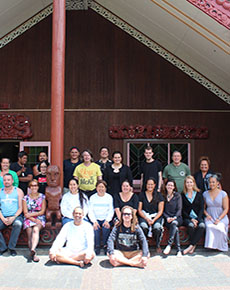Hawai’i and New Zealand universities championing revitalisation of indigenous languages

A Hawaiian Language Studies expert from the University of Hawai’i West O’ahu has given AUT University a thumbs up for its work in promoting the revitalisation of te reo Māori.
Associate Professor Leilani Basham, whose work focuses on the revitalisation and study of the Hawaiian language, was at AUT University this month with a cohort of her students to observe and learn from best practice language revitalisation models employed at AUT University’s National Māori Language Institute, Te Ipukarea, and the International Centre for Language Revitalisation.
“Language is a carrier for culture,” says Associate Professor Basham. “Your perspective of the world is determined by the language you speak.”
“It’s great to come to New Zealand, and AUT University, and see the various strategies in place to revitalise te reo Māori, a language which bears many similarities to our Hawaiian language.”
“From offering introductory proficiency-based classes for beginners, through to more advanced classes, combined with some fantastic learning resources produced by the University’s very own academic staff and students, AUT University is really championing the revitalisation of New Zealand’s indigenous language.”
Associate Professor Basham also explains how in the late 1980s and early 1990s, a number of language immersion schools were established in Hawai’i based off the success of New Zealand’s own Māori language immersion schools.
“In Hawai’i our punana leo programme and kula kaiaouni schools have done a fantastic job to help revive the language in our Hawaiian youth,” says Associate Professor Basham.
Pūnana leo, public Hawaiian-language immersion preschools, are based on New Zealand’s Te Kōhanga Reo ¬– a total immersion te reo Māori family programme for young children from birth to six years of age.
Kula Kaiaouni follows a similar model to New Zealand’s Kura Kaupapa Māori - Māori-language immersion schools where the philosophy and practice reflect Māori cultural values with the aim of revitalising Māori language, knowledge and culture.
“Together, these programmes are helping Hawai’i break away from a history of language disconnect and forced assimilation when the English language was made the only medium of instruction in all schools in Hawaii in 1896.”
“The full revitalisation of te reo Māori and Hawaiian has a long way to go yet, especially on a governmental and policy level, but, the hope is, that by continuing to work together, we can achieve greater bilingualism,” says Associate Professor Basham.
Professor Tania Ka’ai, Director of Te Ipukarea and Professor in AUT’s Faculty of Māori and Indigenous Development/Te Ara Poutama, says it is an honour to be able to collaborate with the University of Hawai’i West O’ahu.
“The same way they are learning from us, we are learning from them,” says Professor Ka’ai.
“The benefit of these sorts of cultural exchanges for AUT and Te Ipukarea is twofold: there is the sharing of knowledge about relevant and effective methods of teaching language for the revitalisation of endangered languages and, celebrating the partnership that exists between AUT and the University of Hawai’i West O’ahu.
Students selected from Te Ara Poutama’s advanced te reo Māori undergraduate class attended an immersion Hawaiian language school for a week in July 2013 which was organised by Associate Professor Basham.
“This year, it was great to see the University of Hawai’i West O’ahu come to us,” says Professor Ka’ai.
“It is really important that language revitalisation initiatives like this continue to thrive; where these two groups are able to host immersion schools every alternate year as an expression of a dual institutional commitment to language revitalisation.”